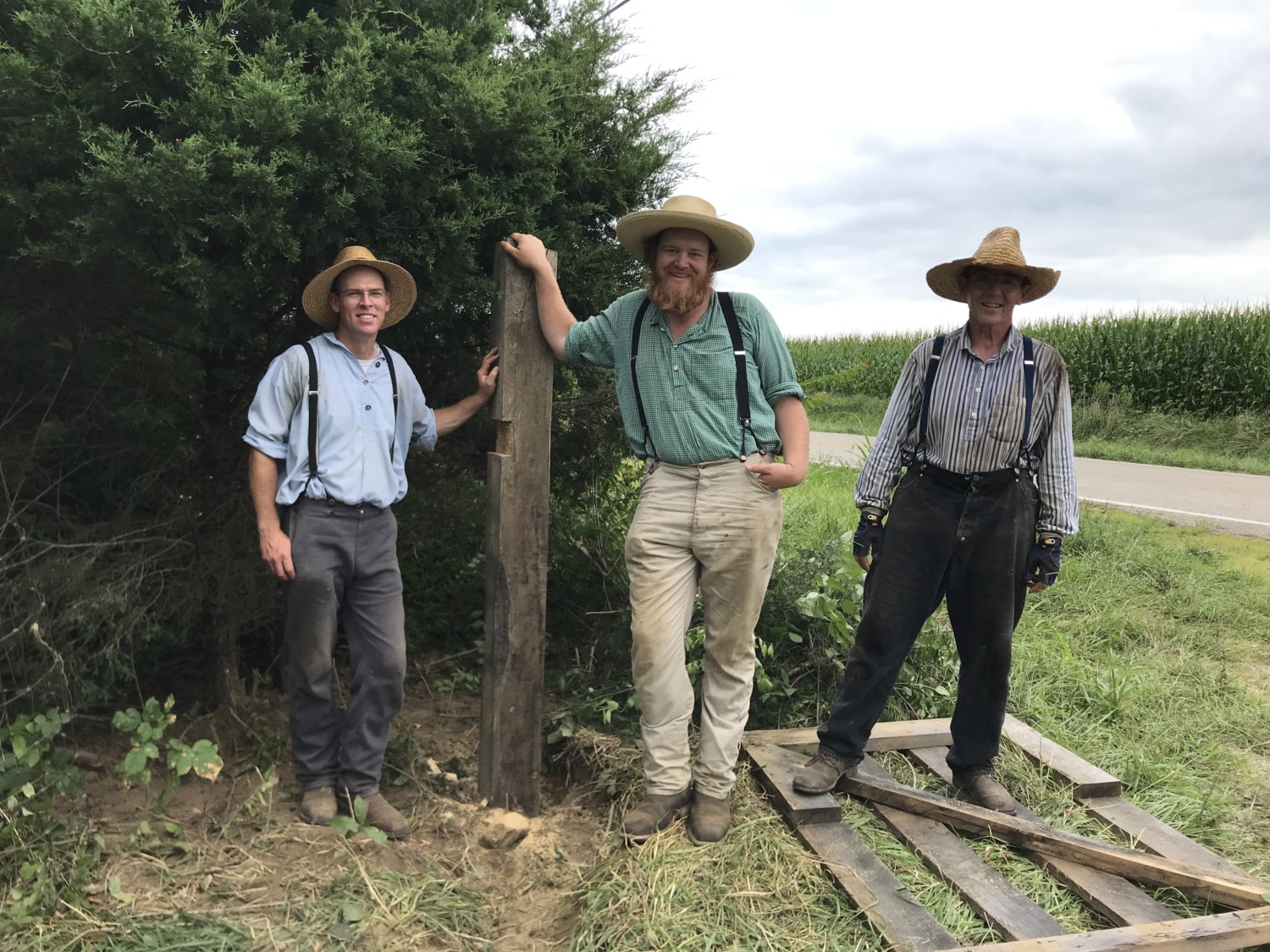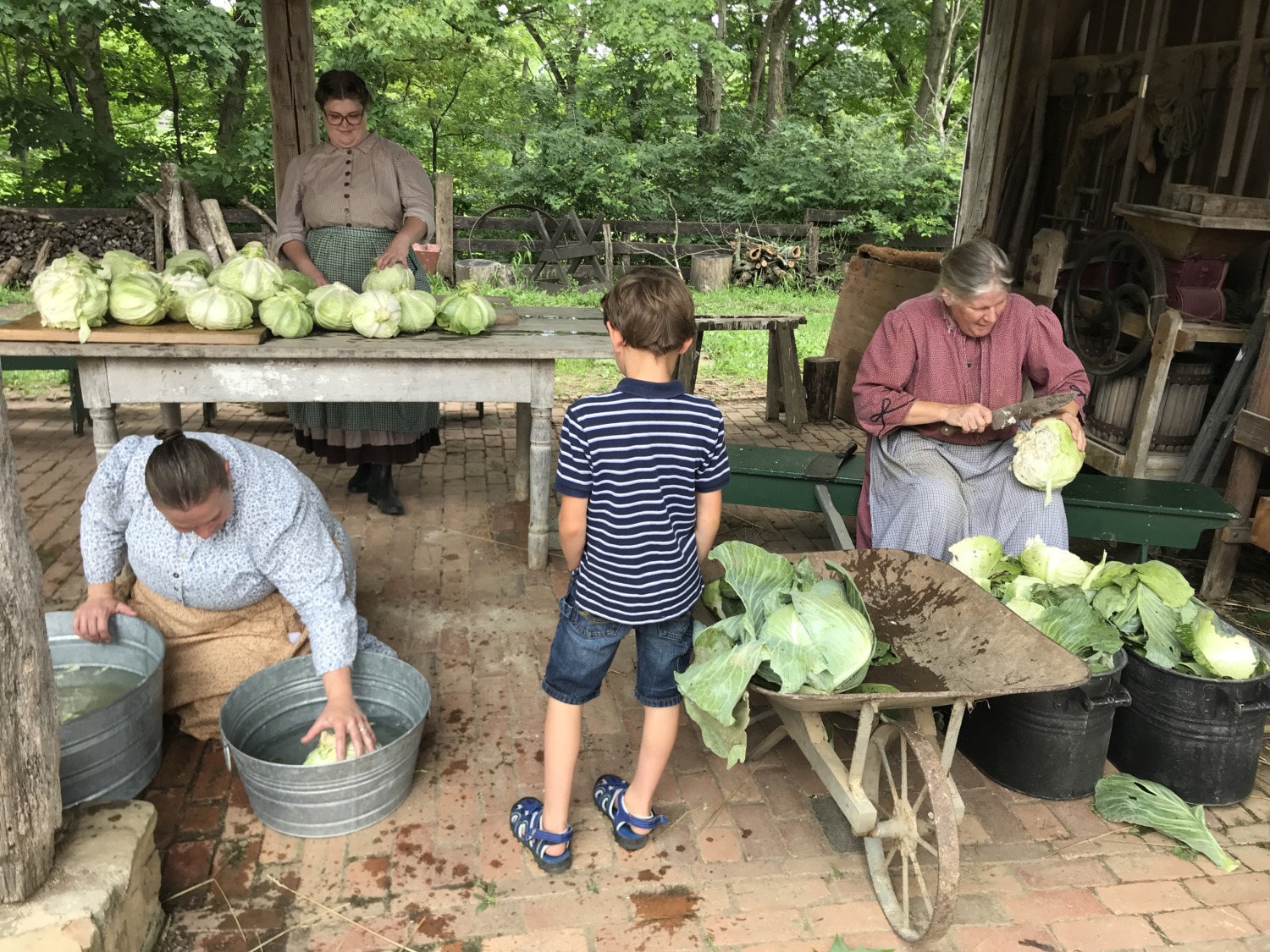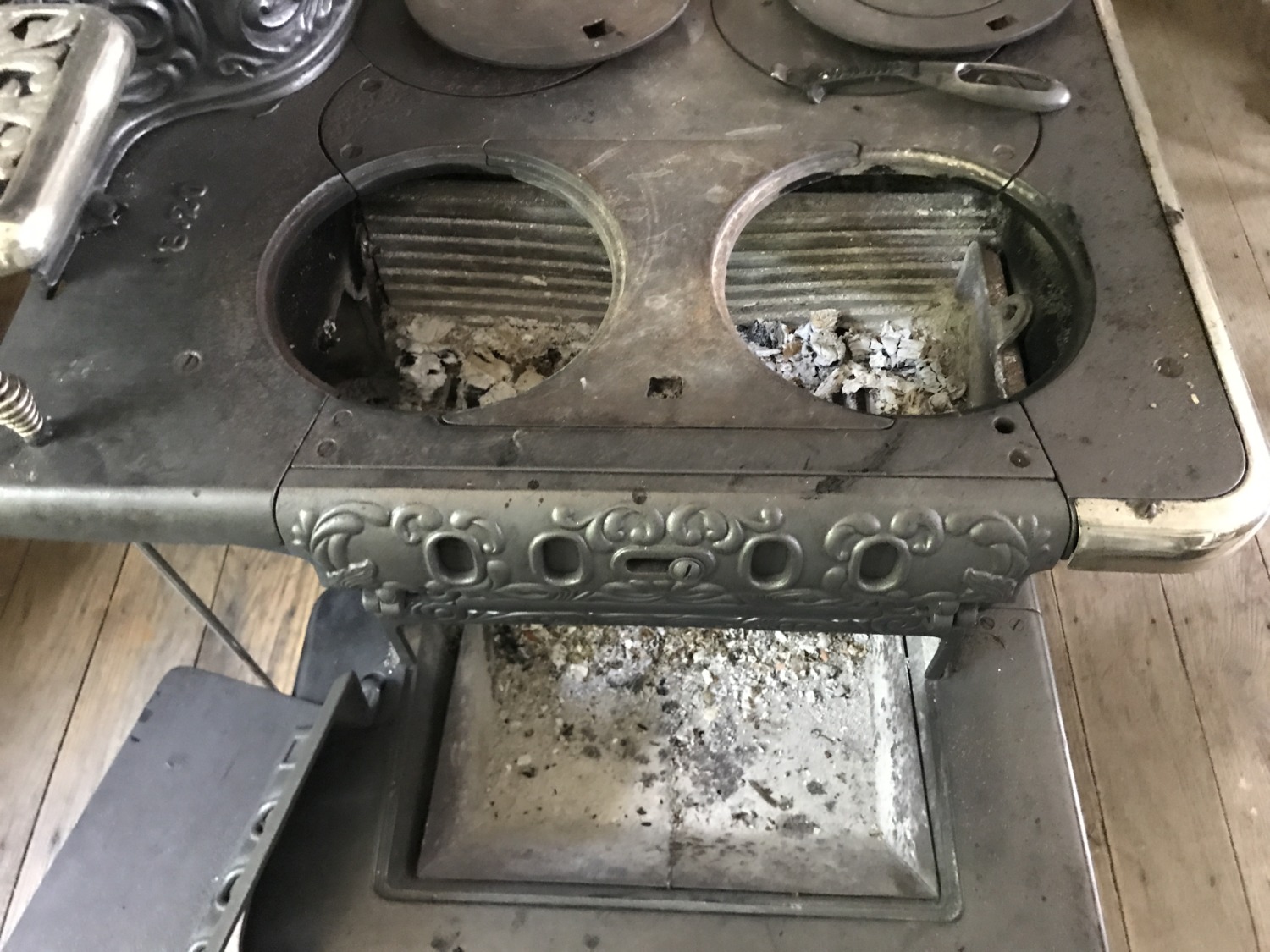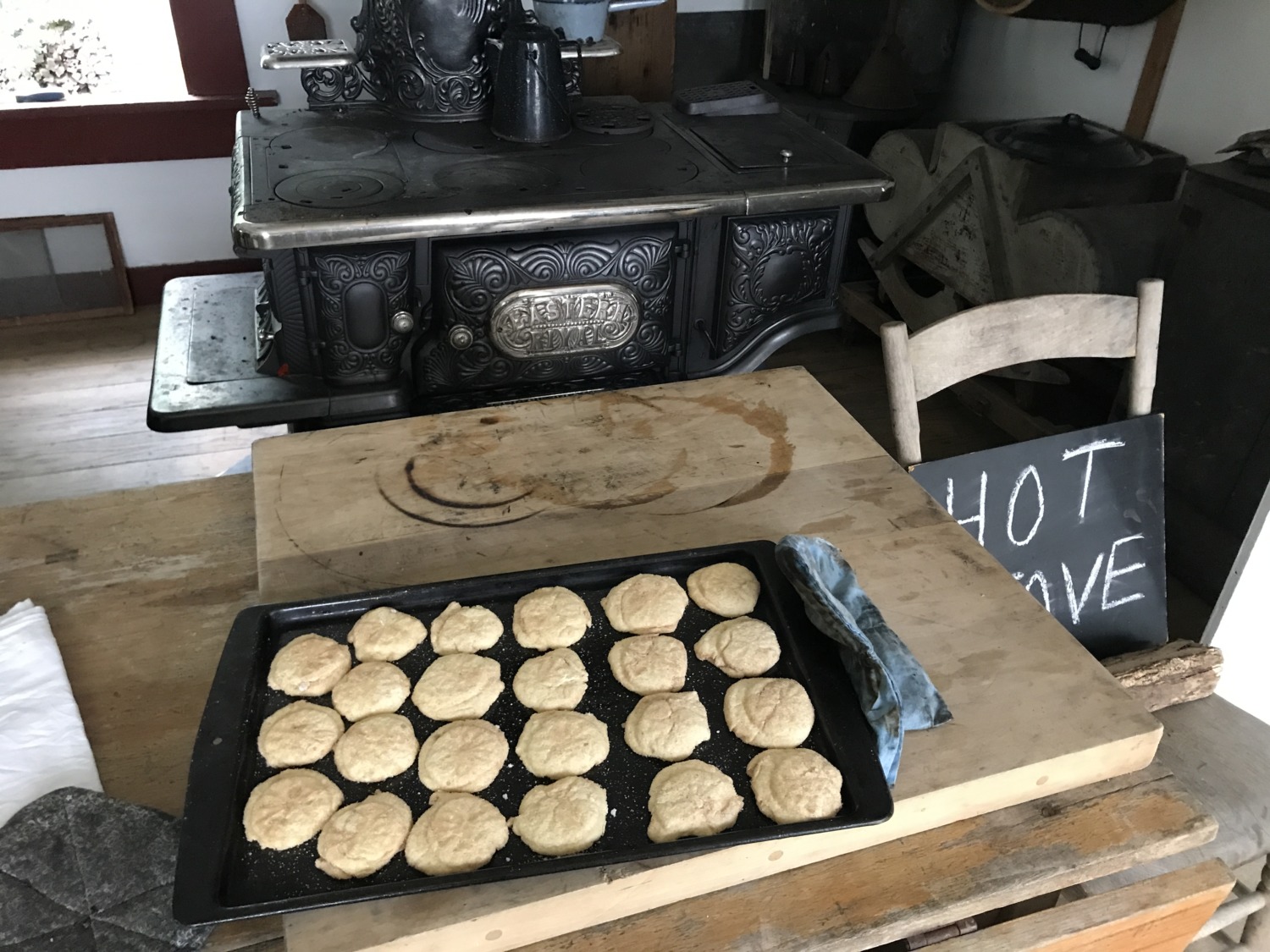Tom and I have now been volunteering for two months at the Slate Run Farm. We volunteer one day a week, from 10 am until 4 pm. I really like the six hour days. Working on the farm is hard, physical labor and I am tired at the end of that time. The farm is open until 6 pm and I think Tom would be glad to stay eight hours.
We now have a pretty good idea of what every day life on a farm in the 1880’s was like. There is men’s work and women’s work. The women are in charge of the house, food preparation and preservation, the garden, and the chickens. The men are in charge of the livestock, the fields, and the equipment. It is a fair division of labor, with all of us working very hard all the time.
After two months, we have settled into a routine. When Tom and I arrive in the morning, we head to our respective areas of work. I go into the house and look for Natelle or Donna, the two staff women I work with most of the time. Tom heads to the barn to find Eric or Harmon, the two staff farmers he works with.

Yesterday when we arrived, Harmon was waiting with a shovel as we walked up the path. He said he was waiting for Tom because he knew he would want to use the shovel. Tom, Eric, and Harmon worked all day on replacing the gate posts at one end of the farm. The posts had rotted. It was harder work that it would have been in the 1880’s because someone sank each post into about 300 pounds on concrete. Thus the shovel Harmon had been holding. They worked on it all day and got the posts replaced. Just the kind of work Tom likes: hot, dirty, and lifting heavy things.
Tom has also been spending a lot of time in the pumpkin patch. It is an acre of pumpkins and always needs hoeing. Whenever he has some time, he heads out there with the hoe. Tom likes hard, physical labor. One day Harmon told some visitors that we have five draft horses. We only have four draft horses, but Harmon said Tom increased the number to five.

My time has been divided between the kitchen and the garden. Everything in the kitchen garden is getting ripe all at once. The tomatoes have to be harvested every other day and there are a lot of them. So far I have harvested six bushels of tomatoes by myself. It is something I can do without supervision, so it is a good use of my time. Once the tomatoes are harvested, they have to be washed and prepared for boiling. We add some spices, then mash the stewed tomatoes for juice. We can some of that, then boil it down further into sauce. Then the sauce or juice is put into jars and “canned.” All of this has to be done on the days the tomatoes are picked, so it is pretty constant labor this time of year.

I harvested all the onions and they are currently on drying racks. We harvested 40 heads of cabbage and chopped them up for sauerkraut. The sauerkraut is sitting in huge crocks in the root cellar fermenting. In a couple of weeks we will can all of that. The canning equipment is out in the summer kitchen and will remain there until we have preserved everything from the garden.

We have already put up a dozen jars of lime pickles. Lime pickles are very green and crisp. They are made with pickling lime. The cucumbers are picked, cut up, then bathed in pickling lime. After that they have to be washed very thoroughly and bathed in vinegar and alum. If all of the pickling lime isn’t washed off, it can neutralize the vinegar which can cause botulism. Then the pickles are boiled and canned. This process takes several days but everyone really likes these pickles.
In addition to working in the garden, I have been learning to use the woodstove. First I had to learn to get it started and since then I have been learning how to bake in it. Before I can start the woodstove I have to clean out the previous days ashes and clinkers. I sweep out the place where the wood goes, then empty the ash bin into a container outside. The ashes are used in the privy and in the garden.

After I make sure the water reservoir is full, I start the fire. At first, all the pieces on the top of the stove are off and the air vents are fully open to make sure the fire is drawing as much oxygen as possible. Once the fire is going well, I can slowly close the openings up, making sure the fire is still drawing well. It can be a little smoky until I get all the openings closed so that the smoke is only going through the chimney.
The first day I tried to get the fire started, it took me two tries to get it going. The other women told me to use paper abundantly to get the fire going well. Fortunately we have a very nice pile of wood in the woodshed as well as another pile of aging wood behind it. There is an abundance of dried wood that is cut to fit the wood stove.
Yesterday I was deemed sufficiently skilled at the woodstove that Donna suggested I bake some cookies. I got the woodstove started without any problem – one match – ha! While the fire was getting underway, I filled up the kettle at the pump. We always have a kettle of water on the stove so we have hot water for washing dishes. I added some more wood to the stove and went out to work in the kitchen garden for a while. The stove needs more wood every 15 minutes or so because I can only get about three small pieces of wood in it at a time.
Donna put a shepherd’s pie in the oven and added a few more pieces of wood. I took frequent breaks from the garden to make sure the fire was still going. When all the food was ready, all of us ate lunch together. We had Donna’s shepherd’s pie (delicious!) with canned pears, pickles, beets, and fresh tomatoes. I had made a blackberry cobbler at home and took that in for dessert.
We were sitting at lunch, talking and relaxing, when I realized I had not checked the fire for a while. I went in to the summer kitchen and, sure enough, the fire was out. It was fairly easy to get started again, because there were still hot coals, but it took half an hour to get back up to temperature. During that half hour I cleaned up lunch and did the dishes. I do the dishes most of the time because it is another thing I can do without supervision.
After all the dishes were dried and put away, I mixed up the cookies and got the first tray in the oven. The cookies are called “Mother Hubbard Cookies” and are a basic sugar cookie recipe from a period appropriate cookbook. One of the farmhands had complained that the cookie jar has been empty for a while, so it was time to fill it. After 15 minutes, the cookies were done and I put the second tray in the oven. Another 15 minutes and the second tray was done and I put in the third tray.

Fifteen minutes later I went out to check and the cookies were not done. I wasn’t sure why, so I left them for another five minutes and then went back to check again. Not done. In fact, the cookies weren’t even hot. I had forgotten to put more wood in the stove. The fire was out again. So, for the third time that day I restarted the fire. It took another half hour for the stove to get hot. About ten minutes after that the third tray of cookies was done and I put the fourth and final tray in.
I didn’t want to add too much more wood because this was the last thing we were doing with the stove for the day. So I decided to “open” the oven. There is a little door that can be open or shut between the fire and the oven. When it is open the oven gets hotter. We usually leave it closed because the oven can easily get too hot. I reached for the latch that opens the oven and promptly burned my finger. The front of a woodstove is just as hot as the inside, something I had forgotten. When Natelle and Donna heard me yelp, they came to check out the burn. They sympathized by showing me burns they had gotten from the woodstove over the years. They also assured me I would get the hang of the woodstove eventually.
Tom and I have really enjoyed our two months volunteering at Slate Run Farm. We are learning a lot and enjoying working with some local folks. The farm is a very busy place, especially in the cooler mornings. Last week we had over 1,000 visitors, most of them families with young children. We see lots of grandparents and kids. The farm is free and the kids love looking at the animals, pumping water, and helping to weed in the garden. One youngster proudly told me that every Friday is Farm Day and every Friday he comes out to “work” on the farm. It makes us glad to work on the farm too.
